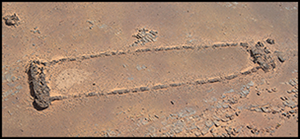architecture - pannous/hieros GitHub Wiki
The history of architecture is especially revealing for the development of civilization
Stone structures in Arabia 5000 BC, during Holocene Humid Phase (c. 8000–4000 BC)
The structures range in form from burial cairns, tower and ‘pendant’ tombs (Braemer et al. 2001; Guagnin et al. 2020), to megalithic features (Zarins 1979; Gebel 2019; Munoz et al. 2020), to monumental animal traps (‘kites’; Kennedy et al. 2015) and open-air structures (‘gates’; Kennedy 2017) renamed to mustatil (مستطيل ) being the Arabic for ‘rectangle’.

Flat unworked slabs were laid in courses, or, alternatively, unworked boulders of local stone were stacked and fitted together. The head generally ranges from 10–50m in length and 0.3–1.2m in height, in most instances the walls are preserved to their original height.
These chambers range in size from 2.8 × 2.8m to 10 × 3m. Several examples are characterised by doorways (<0.5m) that connect the chamber to the courtyard. Gladiator/Torero outlet ?
Associated features
entranceway in the base
Discrete cells are generally identical in size, with diameters ranging from 1–2m. While interlocking examples vary in size, the outer cells are generally smaller (1–1.3m), and central cells progressively larger (1.8–2m). As these cells are positioned parallel to the base of the mustatil, a small passageway is formed between the outer edge of the base and the cells, through which the entranceway and courtyard of the mustatil are accessed.
Central orthostats are fashioned from local stone and range in size from 1–1.5m in height. No decoration is discernible. clusters of pillars, with up to 50 associated with one mustatil. contemporary I-type platforms ranging in number from one to six per mustatil, and from 16 × 7m to 42 × 16m in size.

the courtyard is rarely marked by one or more central dividing walls, creating up to four distinct parallel courtyards running from base to head. race tracks?
on hillsides, mustatils were invariably oriented perpendicular to the slope, upon narrow sandstone mesas or ridgelines were usually oriented to take advantage of the longest available edge.
Mustatils and platforms built upon hillslopes are often visible from great distances, suggesting that prominence within the landscape was a desirable characteristic.
Mustatils are frequently clustered together in groups of between two and 19
a few mustatils were constructed with their heads positioned beneath rock overhangs
in situ faunal remains: specifically, horns and cranial elements. A variety of domestic and wild taxa were identified, including cattle (Bos sp.), sheep/goat (Ovis sp. and Capra sp.) and gazelle (Gazella sp.), with cattle comprising the bulk of the assemblage. These remains can be interpreted as ‘offerings’, as they were deposited around a large upright stone (betyl) positioned in the centre of the chamber.
No human remains or evidence for domestic occupation were identified
A ritual function for these structures is also suggested by their size and prominence in the landscape, as well as the low height of the long walls (0.3–0.5m) and narrow entranceways, which suggest that mustatils could not have functioned as animal pens. Moreover, none of the components of these features can plausibly be interpreted as the remains of permanent or seasonal occupation. Nor is there evidence to suggest that these structures were ever roofed. (KF: hold up! Tents with hides fastened by stones?)
The architecture of these mustatils suggests that their use involved an element of procession. Their narrow entranceways indicate that the structures were accessed in single file.
small numbers of artefacts at four of the 39 mustatils visited, comprising exclusively chipped stone. A flaked micro core from IDIHA-F-0003301 (Figure 9D) and an obsidian bifacial foliate from the courtyard of IDIHA-F-0011394 (Figure 9E) find their closest parallels in Neolithic northern and north-western Arabia, otherwise devoid of cultural material. no evidence for contemporaneous human burials in or around mustatils, although further excavation is required: later funerary activity, being frequently superimposed by ringed tombs. In southern Arabia and the Levant, similar tombs have been dated to between the fourth millennium BC and the third century AD
Mustatils are frequently found in direct stratigraphic association with one or more other structures not of the associated forms discussed above, such as funerary monuments and ‘kites’. The 118 examples of such relationships recorded in aerial photographs show that, for the most part, mustatils were overbuilt (or were structurally robbed), making the mustatil structures sequentially earlier. In rare cases, one mustatil overlies another, further suggesting that they are amongst the earliest stone-built monuments in north-western Arabia.
Kites are generally dated to the Neolithic–Chalcolithic in the Levant, with some possible exceptions dating to the fourth to third millennia BC
The largest mustatil built from basalt boulders measures 525m in length. The structural weight of this feature is approximately 12 000 tonnes. Individual construction stones weigh from 6–500kg. a group of 10 people could construct a mustatil in excess of 150m in length over a two- to three-week period. Similarly, larger structures up to 500m in length could have been constructed by a group of 50 people in as little as two months.
Neolithic/Chalcolithic phenomenon in which ritual structures functioned as symbolic demonstrations of collective power and legitimacy
The apparent ritual deposition of animal horns and cranial elements, offers the first evidence for the possible existence of a Neolithic cattle cult in north-western Arabia. Cattle were a vital commodity for the early pastoral inhabitants of Arabia . The importance of this relationship is highlighted in the rock art of the region, with scenes of both cattle herding and hunting frequently appearing
Shi'b Kheshiya in Yemen, 4400 BC, structures have been associated with territoriality, feasting and the control of pastoral resources
investigations in the Negev Desert have revealed a number of large, rectangular, ‘open-air sanctuaries’ almost all of which date to the sixth millennium BC